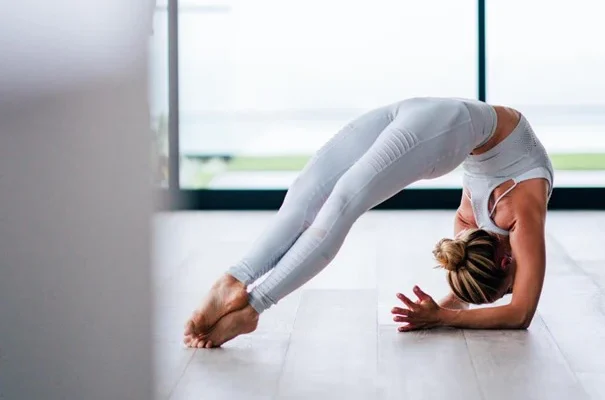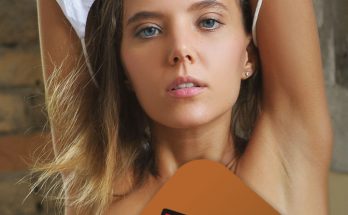[Part 1]
Often criticized “because it looks like acrobatics,” the most difficult (or impressive) yoga postures reflect our own limitations.
Lack of flexibility, joint pain, loss of strength and tone.
Personally, I cannot do any of the very difficult yoga postures listed below but I would like to invite you to take a new look at them.
What if instead of envy and incomprehension, we became a little more curious?
How to access these postures (in reality or in a dream)?
What are their benefits?
What muscles do they work?
Do not try to reproduce these yoga postures alone at home, without support, you risk injuring yourself.
Likewise, if it’s very hot, remember to adapt your yogic practice!
I’ll take you with me to discover 17 of the most difficult yoga postures, with all my curiosity!
In this first part, discover 9 of them, the rest in December 2023!
1. Headstand pose or sirsasana
This is the first inversion balance posture that apprentice yogis try to master.
It offers a new perspective on the practice and allows you to prepare for other, more difficult balance postures!
Step by step: Join the fingers of both hands and form a triangular base on the ground with your two hands linked and elbows on each side, which will be your base. Lean forward and place the top of your head on the floor, the back of your head against your hands. Move your feet towards your head with your leg straight, your back straightens little by little. Slowly lift your feet off the floor, bend your knees toward your chest. Slowly straighten your hips until your bent knees are pointed toward the ceiling. Slowly straighten your knees, feet rise upwards.
How to prepare: Dolphin pose is a great way to prepare for headstand pose.
Benefits: head rest improves concentration and memory.
2. The 8-cornered posture or Ashtavakrasana
The 8-corner pose might be easier than it seems!
Don’t be afraid to give it a go: if you can hold a low plank for about thirty seconds, you probably have enough strength to perform ashtavakrasana.
Start exploring your inner strength without delay!
Step by step: Start with your legs stretched out in front of you.
Bend your right knee and pass your right arm underneath.
Hook your right knee firmly over your right shoulder.
The palms are firmly anchored to the ground, on either side of the hips.
Raise your left leg and lightly cross your left ankle over your right ankle.
Bend your elbows 90° and tilt your upper body forward, chest and gaze raised.
How to prepare: you should always take the time to warm up before tackling the eight-cornered pose. For this, there’s nothing like a few rounds of sun salutations.
Yoga poses that can help prepare for Eight Angles Pose are side plank, turtle, ladder pose, and baby cradle.
Benefits: in addition to strengthening the wrists, arms and heart, this posture is an excellent self-confidence booster. It helps develop concentration and improves digestion.

3. Firefly pose or Tittibhasana
This yoga posture undoubtedly belongs to the category of advanced postures.
As we can see, it mainly targets the wrists, on which the entire weight of the body rests.
The posture strongly requires the abdominal muscles as well as those of the thighs.
To practice once well warmed up!
Step by step: While standing, spread your legs hip-width apart, with your feet pointing slightly outward.
In a forward bending movement, lean your torso forward and anchor your palms to the ground.
Shift your body weight back by pressing the backs of your thighs against your triceps.
Straighten your arms, engage your abdominal muscles and find balance by lifting your feet off.
Straighten your legs in front of you.
How to prepare: remember to warm up well before moving on to the firefly pose. You can keep it warm for the middle of your session. Wrist balance postures like the crow and all those that strengthen the abdominal muscles like the plank and its variations, the head pose or the warrior III offer an excellent basis for tittibhasana.
Benefits: firefly posture strengthens the abdominal muscles, arm and shoulder muscles. It promotes concentration and allows the yogi to feel their inner strength.

4. The Scorpion or Vrischikasana
Impressive in the strength it requires, the scorpion is far from easy to perform, even for the most experienced.
It is an advanced balancing posture in which the body takes the shape of a scorpion’s tail ready to sting.
Step by step :
Get into dolphin pose.
Raise your left leg as high as possible, well aligned with the body.
Slowly bring the leg back then raise the other leg.
The weight of the body now rests solely on the forearms and elbows.
Reverse your back and bring your feet as close to your head as possible by bending your knees.
The gaze rests on an imaginary point on the ground.
How to prepare for it: Many preparatory postures are there to help you access the effort and demands of the scorpion posture: the handstand posture, the peacock posture or the wheel posture.
Benefits : Scorpio pose improves mind-body coordination, strengthens arms, legs and hips while improving blood circulation. From a mental point of view, it boosts self-confidence and helps combat stress.

5. The wheel or urdhva-dhanurasana
The wheel posture and its many variations is a posture for opening the heart in back flexion.
This yoga posture which activates all the chakras is not recommended for beginners but remains accessible, provided you prepare yourself little by little.
Step by step: While lying on your back, bend your knees, bringing your feet as close to your glutes as possible. Place your hands on either side of your face, pointing your fingers toward your feet. Push the whole body back using the arms and legs to bring the pelvis towards the sky.
How to prepare for it: we train with all the more accessible yoga postures that work on back flexion: cobra, upward facing dog, dolphin, sphinx, etc. Also remember to practice the half-bridge, a simplified version of the wheel, ideal for getting started!
Benefits: the wheel posture relaxes the spine and strengthens the arms and legs. It improves breathing and reduces stress.

6. The flying crow or eka pada galavasan
The flying crow is halfway between the posture of the crow and the pigeon.
A beautiful balance on the wrists that gives the impression of flying!
Step by step: Start standing in chair pose. Shift your weight to your left foot. Lift your right foot off the ground. Keeping both knees bent, cross your right ankle over your left thigh. Begin to enter a forward bend on your right shin. Bend your left leg enough so that you can place your palms flat on the floor. Hook the toes of your right foot around your upper left arm. Bend both elbows to support your right shin. Lean your torso forward, resting your right shin on your arms. Lift your left foot off the ground and straighten your leg.
How to prepare for it: work on yoga postures that require the strength of the wrists: upward facing dog, downward facing dog, plank, etc. A prerequisite is of course knowing how to do the crow posture and that of the pigeon to properly prepare hip opening and arm strength!
Benefits: the flying crow pose provides general strengthening of the body, with emphasis on the arms and abdominal muscles. As it is difficult to execute, this posture brings humility and confidence to those who know how to persevere. Once successful, a feeling of strength will be your reward.
LEFT.
How to prepare for it: by working on all the hip opening postures such as the butterfly, the happy child, the garland, the lizard, etc… but also the variations of the pigeon posture (pigeon lying on its back, pigeon on the stomach, etc.)
Benefits: The king pigeon offers an unparalleled all-round stretch and works the hips, spine and legs. Practiced regularly, this posture helps improve blood circulation, strengthen the digestive system and stimulate the abdominal organs.

7. Forearm balance or Pincha Mayurasana
Pincha Mayurasana is an impressive balance yoga pose that features forearm support.
With practice and patience, it is accessible and provides another way of finding balance!
Step by step: Start in plank pose with legs and arms straight. Lower your elbows and place your forearms on the floor. Position your hands to form the tip of a triangle with your elbows. Lift your hips and bend your knees to gently walk your feet toward your hands. Lift one leg up, then the other leg. Raise both legs in arrows. Option: lower them gently onto the head.
How to prepare: Plank and candle poses are great ways to prepare for Pincha Mayurasana.
Benefits: Pincha Mayurasana strengthens the arms and shoulders while improving your balance and loosening the hamstring muscles.

8. The King Dancer or Asana Natarajâsana
It’s the pretty posture with a classical dance feel, which highlights the grace and light of the body!
Step by step: From mountain pose, shift your body weight onto one leg. Stretch the other leg back, the hand on the same side grabs the ankle from the outside. The bust is straight, the hips aligned and the gaze is straight ahead.
How to prepare: practice standing balance postures like eagle or standing pincer to properly practice grounding on one foot. And for opening the hips: all the postures that make them more flexible. You may not be able to lift your leg all the way up the first time. Don’t give up: use a strap to gradually achieve the complete posture of the dancer king.
Benefits: Natarajâsana is a posture that works on anchoring, flexibility, fluidity and balance. Also called the cosmic dancer posture, it is a posture that teaches letting go!
Let’s tackle the remaining poses we discussed in our 19 most difficult yoga postures post.
If you missed the first part, here it is!
Without further ado, here is the rest:

9. Reflection with one foot behind the head or eka pada sirsasana
This posture is simply impressive!
Having a smile in eka pada sirsasana is probably a miracle…or many hours of training!
Step by step: From stick pose, raise your right leg, bend your knee and place it behind your head. The left leg is folded on the ground, the hands are in prayer.
How to prepare for it: a background as a dancer, natural flexibility or the patient work of many years of yoga are necessary to succeed in this posture!
Benefits: the thinking posture with one foot behind the head strengthens the back, neck and shoulders. It increases blood flow and circulation, especially to the back of the body.

10. The formidable face or ganda bherundasana
We reach the heights of yoga: this yoga posture is ranked 56 out of 60 on the Iyengar yoga difficulty scale.
Step by step: Starting from a position lying on your stomach with your chin on the floor and elbows bent, lift your legs and arch your back until your feet are resting on your head. If you can, stretch your legs towards the sky.
How to prepare for it: by starting to do yoga from a young age? by being a top athlete? I ask you 😉
Benefits: Great facial posture improves blood circulation, respiratory system and tones the abdominal organs.

11. Fetal (or embryo) posture or Garbhāsana
This yoga posture is most surprising but completely accessible to anyone who wants to take up the challenge.
Step by step: from lotus posture, bring the bent legs closer to the face, so that they are balanced on the gluteal muscles. Insert your arms into the free space between the thighs and calves by bending your elbows and bringing your hands towards your head. The hands can be in prayer, in meditation or placed flat on the head.
How to prepare: by working on the lotus posture, the basis of Garbhasana.
Benefits: Perfect back tonic, fetal posture also improves elimination and breathing.

12. The frog or Bekasana
Surprisingly, this posture perfectly imitates the famous batrachians, while energizing the legs!
Step by step: Lie on your stomach with your chin on the floor. Bend your knees back. Grasping your feet with your hands, press your heels toward the floor.
How to prepare: To feel comfortable in this posture, practice with prone floor postures like bow, sphinx, cobra. Go slowly to work on knee flexibility without injuring yourself.
Benefits: the frog pose offers an intense and tonic stretch that works the entire pelvis and the knee joints.

13. Lotus Leg Headstand Pose or Padma Sirsasana
This is a nice variation of the pose on the head, to go even further in the posture and work on both your balance and the flexibility of the pelvis.
Step by step: From headstand pose, bend one leg and place the foot in half lotus on the other leg. Stabilize the posture. Then bend the other leg and place the other foot on the groin crease.
How to prepare for it: to achieve head pose with lotus legs, you must of course first know how to master the head pose (see point number 1) as well as the lotus pose separately. Then it’s about putting the two together!
Benefits: intense stretching and strengthening of the entire body.

14. The Flying Warrior or Visvamitrasana
Also known as flying compass or side angle, is an advanced yoga posture in the practice of Ashtanga Yoga.
Step by step: From downward facing dog, raise your right leg. Bend your right knee and bring it forward, towards the elbow of your left arm. Grab the right foot with the left hand, bringing the right knee a little closer to the chest. With your left hand, grab the little toe of the right foot. Slowly begin to straighten your leg. Ultimately, we can no longer hold our ground!
How to prepare for it: by exploring all the slightly less arduous “sister” postures that allow you to lay a solid foundation: the triangle, the posture of the big toe held, the lying posture with your feet in hand, the plank on the side, the half-moon or the flight of the wise Kaundinya.
Benefits: the flying warrior pose offers an unparalleled opportunity to work on the flexibility of your legs and the openness of your shoulders.

15. The peacock or Mayurasana
The peacock yoga posture is one of the unfair postures because despite its apparent difficulty, some yogis will get there quite easily and others will take years to master it.
The outstretched legs levitating above the ground recall the long tail of the peacock, when it is not on a wheel.
Step by step: In a kneeling position, place your hands flat on the floor, facing outwards and pointing towards your knees. Bend your elbows to form a solid base. Lean forward and place your stomach on your elbows. Bring your head to the floor, then straighten your legs back. Take flight by lifting your legs, one after the other, contracting your abdominal muscles.
How to prepare for it: work on postures that deeply engage the wrists and shoulders to acquire the strength necessary to get into peacock pose, unless you get there naturally 😊
Benefits: the peacock pose undeniably develops strength, physical and mental, works the back muscles, glutes, quadriceps and even the calf muscles to fight against gravitational force.

16. Elephant trunk or eka hasta bhujasana
Simply stunning, the elephant trunk posture requires great strength in the arms.
Step by step: Starting in stick pose, with your hands on either side of your hips, bend your right knee and place it as high as possible on the outside of your right arm. Pressing on the hands, lift the pelvis and the left leg straight.
How to prepare: to have a good foundation before launching into the elephant trunk pose, practice the crow pose, the pendant pose as well as the boat.
Benefits: Eka hasta bhujasana in addition to strengthening the arms and torso, improves concentration and digestion. The posture energizes the body and mind while developing inner strength.

17. The legs behind the head posture or dwi pada sirsasana
Dwi pada sirsasana is one of those very impressive yoga postures where you should not skimp on the suppleness or flexibility of the body!
Step by step: Start by settling into stick pose. Bend your right knee and grab your right ankle. Gently bring it closer to your head to “tie” it behind your neck. Do the same with the other leg. This posture can be done seated but also in the lying position. A possible variation is to cross your ankles behind your head.
How to prepare: before you can put both feet behind your head, start by trying to put one in the posture of Reflection with one foot behind your head or eka pada sirsasana (see number 10). In general, work on hip opening and leg flexibility postures to best prepare for the posture of the legs behind the head.
Benefits: One of the number 1 benefits of dwi pada sirsasana is of course the incredible work on flexibility. The legs behind the head posture activates blood flow throughout the body, ideal for eliminating toxins. It activates the fire of digestion.

18. The fallen angel or Devaduuta Panna Asana
This is the more advanced variation of the twisting crow pose, itself a more advanced variation of the crow pose. As you can see, yoga postures come in multiple variations of twisting, balancing and back bending, to explore our body!
It is also a very aesthetic posture which will appeal to your qualities of grace and lightness as a dancer.
Step by step: place yourself in a squatting posture, balancing on your toes, your hands touch the ground with your fingertips on either side of your bent knees. Rotate with your torso to the right side, the left elbow is placed under the right knee. Lower your torso and bend your elbows to balance by placing both knees together on your left elbow, as in the twisting crow pose. Raise your left hip and foot.
How to prepare: Before launching into fallen angel pose, stretch your neck and wrists. Seated or lying twists, as well as different variations of the side plank are excellent preparation postures.
Benefits: The fallen angel pose improves blood circulation and body coordination. It strengthens the whole body and works on flexibility.

19. Double-Legged Inverted Stick Pose or DwiPada Viparita Dandasana
Probably the yoga pose with the longest name of all, which is a very, very advanced backbend with a beautiful chest opener! Compared to other postures on this list, it may seem easier, but don’t let appearances fool you: this posture is and will remain very intense!
Step by step: While lying on your back, bend your knees and place your feet on the floor hip-width apart. Straighten your pelvis and bend your elbows, placing your hands flat behind your shoulders. Lift your shoulders and head off the ground, straighten your arms. Once in full wheel pose, slowly drop your forearms to the floor and interlace your fingers behind your head. Straighten both legs and lift your chest by pressing on the ground with your feet and with the base made of your hands.
How to prepare: to be able to perform the inverted stick pose with two legs, you must first know how to do the wheel pose with your arms outstretched.
Benefits: They are multiple, starting with the complete stretching of the body, the strengthening of the legs and the opening of the chest.






